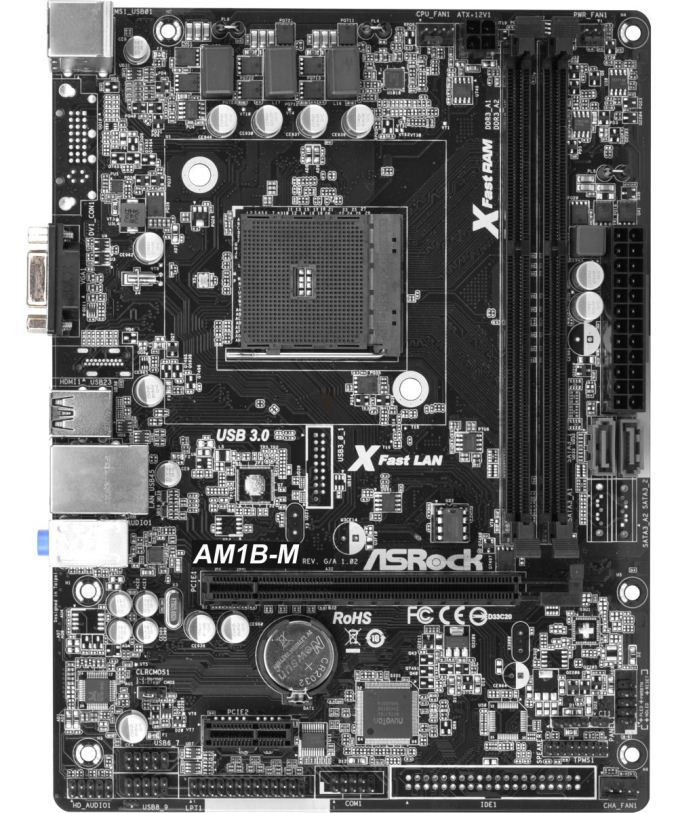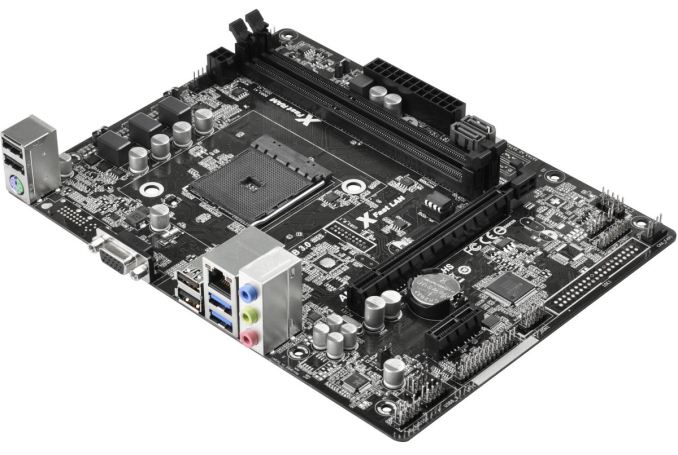The AM1 Kabini Motherboard Preview: Analyzing the Hardware
by Ian Cutress on April 19, 2014 2:00 PM ESTASRock AM1B-M
ASRock’s first motherboard falls under the $40 mark and also represents a slightly different variation on the theme. So far no two motherboards have been alike, and the ASRock AM1B-M exchanges the higher audio and video outputs instead for more rear USB 2.0 ports and an extra fan header. On the face of it, this does not seem like a good deal compared to the previous MSI, unless you need extra USB 2.0 ports.
The AM1B-M seems to have a lot of spots unoccupied by connectors. This is mostly likely due to variations of products, where the cheapest tends to have expensive connectors removed to hit a price point. We see two SATA ports missing, an IDE pin layout but no connector, and also a DVI connection missing on the rear panel. In the middle of the board is also a USB 3.0 pin layout, suggesting that another model has an additional USB 3.0 controller as well.
What the ASRock AM1B-M also does differently to all the motherboards we have examined before now is include a COM port, LPT port and a TPM port on the same PCB. It would be interesting to see which niche that combination would be good for.
The PCIe layout uses the PCIe 2.0 x4 from the chipset in a full sized slot, with an additional PCIe 2.0 x1 underneath. Thankfully the SATA ports are alternate facing for removing locking SATA cables, and the placement of the 4-pin CPU connector also helps cable routing. The AM1B-M has three fan headers, one more than the others – two on the top of the motherboard either side of the DRAM slots, and a third on the bottom right.
The AM1B-M has four USB 2.0 ports on the rear panel, or what I like to call my happy minimum (installing an OS via USB helps with at least three USB 2.0 ports). That being said, the sole VGA connector looks lonesome, and the ALC662 audio codec is not a particularly good choice.
| ASRock AM1B-M | |
| Price | Link |
| Size | Micro-ATX |
| CPU Interface | FS1b |
| Chipset | Kabini |
| Memory Slots |
Two DDR3 DRAM slots, supporting 16GB Single Channel, 1066-1600 MHz |
| Video Outputs | VGA (2048x1536 at 60 Hz) |
| Onboard LAN | Realtek RTL8111GR |
| Onboard Audio | Realtek ALC662 |
| Expansion Slots |
1 x PCIe 2.0 x16 (x4) 1 x PCIe 2.0 x1 |
| Onboard SATA/RAID | 2 x SATA 6 Gbps |
| USB 3.0 | 2 x USB 3.0 (Chipset) [rear panel] |
| Onboard |
2 x SATA 6 Gbps 2 x USB 2.0 headers 3 x Fan Headers 1 x TPM Header 1 x LPT Header 1 x COM Header Front Panel Header Front Audio Header |
| Power Connectors |
1 x 24-pin ATX 1 x 4-pin CPU |
| Fan Headers |
1 x CPU (4-pin) 1 x CHA (4-pin) 1 x SYS (3-pin) |
| IO Panel |
1 x PS/2 Combination Port VGA 2 x USB 3.0 4 x USB 2.0 1 x Gigabit Ethernet Audio Jacks (ALC662) |
| Product Page | Link |














64 Comments
View All Comments
tuxRoller - Sunday, April 20, 2014 - link
Nvidia's driver's provide performance that is pretty much identical to windows.AMD's is more variable.
From the benchmarks, there looks to be no point in going higher than an nvidia 750.
However, if you're gaming, and you want nice effects, you need that single thread performance.
Flunk - Sunday, April 20, 2014 - link
It's not like either has a very powerful GPU either. Xbox One is equivalent to a Radeon 7790 and PS4 a Radeon 7850. Plus, you don't have the CPU overhead from DirectX.Tranzz - Sunday, April 20, 2014 - link
http://semiaccurate.com/2014/04/16/adding-discrete...MonkeyPaw - Sunday, April 20, 2014 - link
Thanks. I wonder what resolution they were running. It does suggest that you can produce a mostly playable gaming setup for about $200 worth of core components. I wonder if AMD will ever scale Jaguar up even further? 8 cores and dual channel memory could be pretty potent for 50W or so. Might produce more excitement than the FX line.silverblue - Tuesday, April 22, 2014 - link
AMD obviously seems to think that a single, albeit fast, channel is enough to feed a small 'cat CPU. The trouble is, that may have been true for Brazos, but that had two cores and a weaker GPU. It'd be very interesting to see a dual channel Kabini - would it make a difference outside of GPU-based workloads?Mullins also needs a turbo mode, especially if Bay-Trail and its derivatives have one. Being able to ramp up clock speed for a short period of time so that the CPU can return to idle quicker and for longer is one of the reasons why Intel beats AMD for power consumption across the board (regardless of architecture and fab process).
FriendlyUser - Saturday, April 19, 2014 - link
You really can't beat the price. I am almost looking for an excuse to buy one...wolrah - Saturday, April 19, 2014 - link
"I never thought I would ever see a socketed motherboard in 2014 ship with a less-than-gigabit Ethernet port."I think we're at a point these days where anything new coming out with 100mbit ethernet or VGA as the primary display interface should be shunned as an outdated-out-of-the-box product.
VGA in particular, I mean who uses VGA? Even the luddites have mostly abandoned their cannonball CRTs, and a VGA-only LCD has always been the realm of idiocy.
harriharris - Sunday, April 20, 2014 - link
Not defending it myself here or anything... in fact I completely agree, but a lot of business still does. I know my workplace of over 50,000 personnel in a govt agency - every workstation I've sat at in 17 years there has had VGA connected monitors, even now with 16:10 LCDs in most places. They still run XP too... *sigh*xrror - Sunday, April 20, 2014 - link
Sadly another reason for VGA is if your building(s) with overhead projectors are wired with analog VGA. So for where I work that's maybe... 300 or so rooms rough guess.And while we've talked about changing to some sort of digital connection, fun things like HDMI copy projection, splitting to multiple projectors, etc pretty much skyrocket the already formidable costs.
So I dunno, we can't stay VGA forever (nor do we really want to) but we can't afford to switch. At all. No wonder the media services guy can't wait to retire - and I can't blame him.
tuxRoller - Saturday, April 19, 2014 - link
So, I can't get a board with displayport until we reach $50? Why? Isn't displayport royalty free?My issue is that I've a 1440p auria with both HDMI and do BUT, afaict, the HDMI interface doesn't support more than 1080p.
I really hate the HDMI spec. At least with displayport versions you know what to expect.